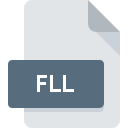.FLL File Extension

FoxPro Dynamic-Link Library
| Developer | Microsoft |
| Popularity | |
| Category | Data Files |
| Format | .FLL |
| Cross Platform | Update Soon |
What is an FLL file?
More Information.
The .FLL file extension was introduced to facilitate the modularization of functionality within FoxPro applications. These files served as dynamic-link libraries, allowing developers to encapsulate reusable code and integrate it seamlessly into their FoxPro projects. Initially, .FLL files provided essential functions for database management, user interface customization, and other application-specific tasks.
Origin Of This File.
The .FLL file format originates from FoxPro, a database management system initially developed by Fox Software and later acquired by Microsoft. FoxPro was widely used for creating database applications, especially in the era before the dominance of SQL-based systems.
File Structure Technical Specification.
.FLL files typically contain compiled code written in FoxPro’s programming language. The structure of these files includes executable routines, data structures, and resources necessary for their operation. The technical specifications of .FLL files may vary depending on the specific functions they provide and the version of FoxPro they are intended for.
How to Convert the File?
Windows:
- Rewrite Code: Rewrite the functionality provided by the .FLL file using a programming language supported on Windows, such as C# or Visual Basic.NET, and integrate it into your application.
- Third-Party Tools: Utilize third-party conversion tools or services specifically designed to convert FoxPro files to formats compatible with Windows environments.
Linux:
- Reverse Engineering: Reverse engineer the functionality of the .FLL file and rewrite it using a programming language supported on Linux, such as Python or C/C++, to create a Linux-compatible library.
- Emulation: Use compatibility layers or emulators like Wine to run FoxPro on Linux and access the functionality provided by the .FLL file.
Mac:
- Porting: Port the functionality of the .FLL file to a programming language compatible with Mac environments, such as Objective-C or Swift, and integrate it into your Mac application.
- Virtualization: Use virtualization software like Parallels Desktop or VMware Fusion to run Windows on your Mac and access the .FLL file within a Windows environment.
Android:
- Rewrite for Android: Rewrite the functionality of the .FLL file using Java or Kotlin, the primary programming languages for Android development, and integrate it into your Android application.
- Cross-Platform Development: Consider using cross-platform development frameworks like Xamarin or Flutter to develop applications that can utilize the functionality of the .FLL file across multiple platforms, including Android.
iOS:
- Rewrite for iOS: Rewrite the functionality of the .FLL file using Swift or Objective-C, the primary programming languages for iOS development, and integrate it into your iOS application.
- Cross-Platform Development: Explore cross-platform development tools like Xamarin or Flutter to create iOS applications that can utilize the functionality of the .FLL file alongside Android and other platforms.
Advantages And Disadvantages.
Advantages:
- Modularity: .FLL files enable developers to modularize code and enhance the functionality of FoxPro applications without reinventing the wheel.
- Reusability: Functions and features encapsulated in .FLL files can be reused across multiple projects, saving time and effort.
- Extensibility: .FLL files allow for the extension of FoxPro applications, enabling developers to add new features and capabilities easily.
Disadvantages:
- Compatibility Issues: .FLL files may not be fully compatible with newer versions of FoxPro or other development environments, leading to compatibility issues.
- Limited Portability: .FLL files are primarily designed for use within the FoxPro environment, limiting their portability to other platforms or systems.
How to Open FLL?
Open In Windows
- FoxPro: Use Microsoft FoxPro or any FoxPro-compatible environment to open and utilize .FLL files on Windows.
- Third-Party Applications: Some third-party applications designed for FoxPro development may also allow you to open and work with .FLL files on Windows.
Open In Linux
- Wine: Install Wine, a compatibility layer that allows running Windows applications on Linux, and then attempt to run Microsoft FoxPro using Wine to open .FLL files.
- Emulation: Use emulators or virtual machines to run Windows on Linux and then open .FLL files using Microsoft FoxPro or compatible software within the emulated Windows environment.
Open In MAC
- Virtualization: Utilize virtualization software like Parallels Desktop or VMware Fusion to run Windows on your Mac, and then use Microsoft FoxPro or compatible software to open .FLL files within the virtualized Windows environment.
- Cross-Platform Tools: Explore cross-platform development tools or libraries that may offer limited support for opening and using .FLL files on Mac, although full compatibility cannot be guaranteed.
Open In Android
- Porting: Rewrite the functionality provided by the .FLL file using Java or Kotlin, the primary programming languages for Android development, and integrate it into your Android application.
- Cross-Platform Development: Consider using cross-platform development frameworks like Xamarin or Flutter to develop applications that can utilize the functionality of the .FLL file across multiple platforms, including Android.
Open In IOS
- Porting: Rewrite the functionality provided by the .FLL file using Swift or Objective-C, the primary programming languages for iOS development, and integrate it into your iOS application.
- Cross-Platform Development: Explore cross-platform development tools like Xamarin or Flutter to create iOS applications that can utilize the functionality of the .FLL file alongside Android and other platforms.
Open in Others
- Web-Based Solutions: Consider converting the functionality of the .FLL file into web-based services or APIs that can be accessed from any platform with internet connectivity.
- Custom Solutions: Depending on the specific requirements and constraints, explore developing custom solutions or integrations tailored to your platform or environment’s needs for accessing .FLL file functionality.













